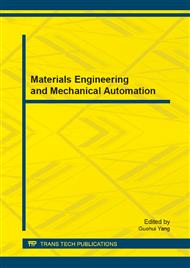p.413
p.419
p.424
p.430
p.437
p.443
p.450
p.458
p.466
Coordinating Motion Planning for a Mobile Manipulator with Multiple Constraints
Abstract:
In this paper, we design a 6-degree of freedom (6-DOF) mobile manipulator and present a method of coordinating motion planning. Through analyzing the structure and motions of our mobile manipulator, we obtain some multiple constraints, including static constraints, dynamic constraints and obstacle constraints. To avoid the multiple results of inverse kinematics, joint angles constraints are adopted. Under the condition of these constraints, we put forward a method of coordinating motion planning to guarantee that the mobile manipulator can get the optimal solution by the maximum fitness method (MFM). The method includes two steps: first, the mobile platform moves from non-operable region to operable region; second, the coordinating motion between mobile platform and machine arm in order to achieve the purpose of dredging and unloading materials. Simulation experiments on the mobile manipulator show the effectiveness of the proposed method.
Info:
Periodical:
Pages:
437-442
Citation:
Online since:
October 2013
Authors:
Price:
Сopyright:
© 2014 Trans Tech Publications Ltd. All Rights Reserved
Share:
Citation:


